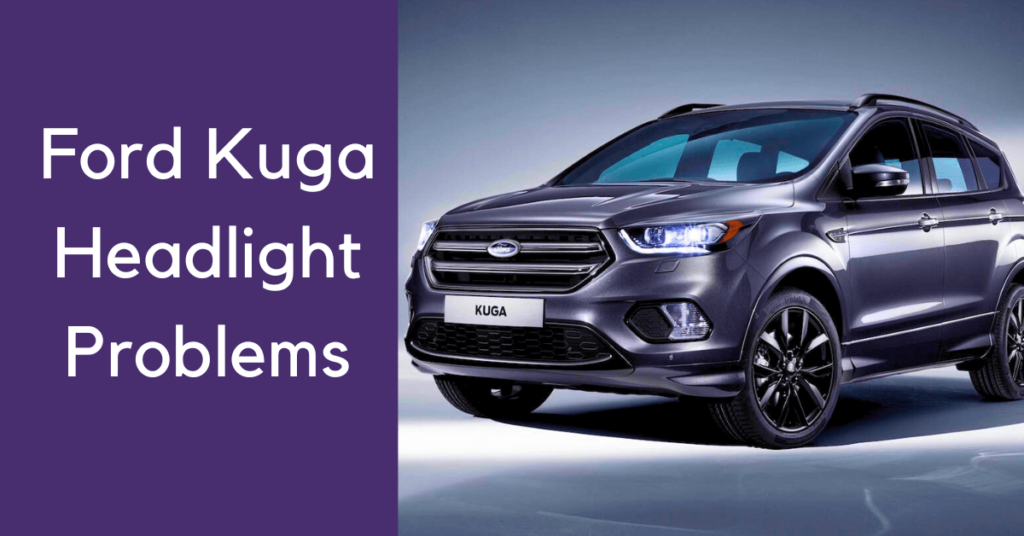
The Ford Kuga is a compact crossover car manufactured by Ford since 2008. In this article, I will discuss common Ford Kuga headlight problems based on my experience and knowledge.
Common Ford Kuga Headlight Problems
1. Ford Kuga Rear lights not working
Rear lights provide great safety to drivers while driving. The rear lights of the car include tail lights, brake lights, reversing lights, fog lights, and turn lights of the car. The rear lights play a pivotal role in indicating the vehicle’s presence, intentions, and braking to other road users. When the rear lights fail to illuminate, it compromises the driver’s ability to communicate effectively with the cars behind.
The problem of rear lights can occur due to various factors such as burnt-out bulbs in one or more of the rear lights. Over time, continuous use of rear lights also leads to the eventual failure of the bulbs. Additionally, issues with the wiring and connectors or fuses also lead to non-illumination because these fuses are associated with the rear lights. A malfunctioning brake light switch, a blown fuse, or problems with the vehicle’s lighting control module can also lead to the failure of rear lights.
how to fix it?
Ford Kuga headlight problems are not simple though. Resolving this issue of non-functional rear lights involves a systematic approach. Begin by inspecting and replacing the burnt-out bulbs. Then, Try repairing or replacing wiring if you find any corroded or loose wiring connected to the rear lights.
Check and replace any blown fuses in the circuit. Testing the functionality of the brake light switch is crucial. It plays a vital role in the operation of the rear brake lights. If these basic measures do not resolve the problem, consult a professional. Seeking professional assistance from a mechanic or auto electrician is highly advisable because they can conduct a more in-depth diagnosis.
2. Ford Kuga dipped headlights become Dim
Dipped headlights are crucial for providing illumination in low-light conditions. When they appear dim, they hinder the driver’s ability to see the road ahead clearly. Dipped headlights can become dim due to various causes. A primary cause is often related to the bulbs themselves. There is a strong possibility that bulbs may be reaching the end of their operational life or have become damaged.
Additionally, issues with the vehicle’s electrical system or Foggy headlight lenses can also cause dimming because the damaged vehicle’s electric system results in a reduced power supply to the headlights, which reduces the effectiveness of the bulb.
how to fix it?
Conduct a thorough examination of the vehicle’s electrical system. Check for any loose or damaged wiring and connections. Addressing and repairing these issues helps prevent many Ford Kuga headlight problems. Ensure the alternator is functioning correctly to maintain a consistent power supply to the headlights. Cleaning or restoring foggy headlight lenses is another crucial step to enhance illumination.
Headlight Problems in Other Ford Models:
- Ford Ranger headlight problems
- Ford Figo headlight problems
- Ford focus headlight problems
- Ford Kuga headlight Problems
- Ford B Max headlight problems
- Ford escape headlight problems
- Ford Flex Headlight Problems
3. Ford Kuga headlights don’t stay on in automatic mode
The automatic mode of Ford Kuga headlights is designed to ensure headlights activate and deactivate automatically based on ambient light conditions. When this functionality fails, it disrupts the seamless transition between day and night driving.
This problem can occur by various factors. A common cause is a malfunctioning ambient light sensor. This is the component responsible for detecting changes in external light conditions. If the sensor is faulty, misaligned, or obstructed, it may inaccurately interpret light levels. This also leads to inconsistent activation of the headlights. Issues with the vehicle’s electrical system can also contribute to this problem.
how to fix it?
Start by inspecting the ambient light sensor. Try ensuring it is free from obstructions and correctly aligned. Cleaning the sensor may improve its functionality. If the problem persists, consider checking the headlight switch and the vehicle’s lighting control module for any malfunctions. If necessary, replacing these components can resolve issues related to automatic headlight activation.
Regularly checking for software updates from the vehicle manufacturer is also advisable. The updated software may address any bugs or glitches affecting automatic lighting functionality. If basic measures do not resolve the problem, consulting an auto service center is recommended. They can conduct a more in-depth inspection. This ensures the proper functioning of the ambient light sensor and associated components. It helps you easily restore the reliable operation of the automatic headlight mode.
4. Ford Kuga Headlights keep blowing
This problem involves the frequent burnout or failure of headlight bulbs. It leads to reduced visibility while driving. A common cause of this problem is a mismatch between the bulb’s wattage and the vehicle’s specifications. Using bulbs with a wattage higher than the electrical system capability can lead to excessive heat. This causes frequent burnout. Voltage fluctuations, faulty alternators, or poor electrical connections can also lead to this problem.
how to fix it?
Start by ensuring that the correct wattage bulbs are being used, as specified in the vehicle’s manual. If bulbs with the correct wattage are still blowing frequently, inspect the vehicle’s electrical system.
Check for voltage fluctuations, loose or damaged wiring, and the overall condition of the alternator. Repair or replace any components that may be contributing to the electrical issues. Upgrading to higher-quality, long-life bulbs may also mitigate the problem. Additionally, consider installing a relay harness to reduce the load on the vehicle’s electrical system. If this troubleshooting does not resolve the issue, seeking professional assistance is advisable.
5. Ford Kuga Auto High Beam not working
Auto High beam headlights help to turn on the high beam automatically. Any problem with the Auto high beam hinders the automatic adjustment of headlights between high and low beams. The problem of auto high beams not working can be attributed to various factors. A common cause is a malfunctioning sensor. A sensor is responsible for detecting oncoming traffic or the presence of other vehicles. Dirt, debris, or damage to the sensor can disrupt its functionality. Issues with the vehicle’s lighting may also contribute to the non-operation of the auto high beam feature.
how to fix it?
Start by inspecting the sensor. It is usually located near the rearview mirror or on the front of the vehicle. Ensure it is free from obstructions, dirt, or damage. Cleaning the sensor may improve its performance. If the sensor appears intact, check the vehicle’s lighting control module and the switch for any malfunctions. Test the electrical connections associated with the auto high beam system. Try repairing or replacing any damaged components.
Updating the vehicle’s software, if applicable, may help to resolve any software-related issues affecting the Auto High Beam feature. If basic measures do not resolve the problem, seeking professional assistance from a dealership or auto service center is advisable.
Maintenance tips for Ford Kuga headlights
Maintaining your Ford Kuga headlights is crucial for safe driving and visibility. Here’s a simple guide to keep them in top condition.
- Regular Checks: Make it a habit to inspect your headlights frequently. Look for any flickering, dimming, or moisture inside.
- Bulb Basics: Ensure you’re using the correct bulb wattage recommended for your Ford Kuga. This prevents overheating and extends the bulb’s life.
- Clean Lenses: Dirty lenses can dim the lights. Clean them regularly with a soft cloth to remove dirt, bugs, and grime.
- Address Flickering Promptly: If your headlights flicker, it could be due to bulb issues, wiring problems, or electrical disruptions. Address these promptly for consistent lighting.
- Condensation Concerns: Moisture inside headlights often results from compromised seals. Regularly check and replace seals to prevent condensation. Proper ventilation is key.
- Dimming Headlights Prevention: Dimming can be prevented by using the right bulb wattage, keeping lenses clean, and addressing electrical issues promptly.
- Non-Functional Headlights: If your headlights stop working, check for burnt-out bulbs, faulty wiring, or issues with the lighting control module. Professional help may be needed for effective diagnosis and resolution.
- Moisture Buildup Prevention: Regularly inspect and replace seals to prevent moisture buildup inside headlights. Good ventilation helps maintain clear visibility.
- Automatic Headlight Issues: If automatic headlights malfunction, it may be a faulty light sensor or problems with the lighting control module. Regular sensor checks and professional diagnosis are essential.
- Proactive Maintenance: Be proactive in using the right bulb wattage, conducting regular inspections, and promptly resolving any issues. This ensures reliable headlight performance in your Ford Kuga.
- Professional Assistance: For complex electrical issues, seek help from a qualified mechanic or auto electrician. Their expertise ensures optimal headlight functionality in your Ford Kuga.
Headlight Problems in BMW Models:
- BMW Mini Headlight Problems
- BMW 1 series headlight Problems
- BMW Headlight Problems
- BMW 5 Series Headlight Problems
FAQs
Q: Why do Ford Kuga headlights flicker?
A: Flickering headlights may result from issues like a faulty bulb, wiring problems, or electrical system issues. Start by inspecting and replacing bulbs, and consult with a professional if the problem persists.
Q: What causes condensation inside Ford Kuga headlights?
A: Condensation is often due to compromised seals. Regularly inspect and replace damaged seals, and ensure proper sealing after any maintenance to prevent moisture buildup.
Q: How can I prevent the dimming of my Ford Kuga headlights?
A: Use the correct bulb wattage, regularly inspect and clean the lenses, and address any issues with the vehicle’s electrical connections to prevent dimming problems.
Q: How do I address moisture buildup in Ford Kuga headlights?
A: Inspect and replace damaged seals, ensure proper ventilation, and consider using a headlight restoration kit to address moisture buildup and maintain clear visibility.
Q: What causes Ford Kuga automatic headlights to malfunction?
A: Automatic headlight malfunctions may result from a faulty light sensor or issues with the lighting control module. Inspect the sensor for damage and consult with a professional for a comprehensive diagnosis.
Headlight Problems in Other Car Models:
Conclusion
In conclusion, By understanding the root causes and implementing effective solutions, Ford Kuga owners can confidently navigate the roads. However, regular maintenance and timely interventions contribute to both the aesthetic appeal and the safety features of the Ford Kuga.
